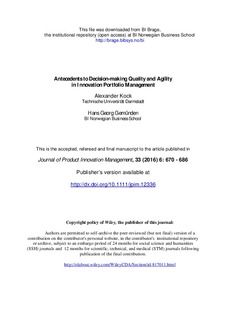Antecedents to decision-making quality and agility in innovation portfolio management
Journal article, Peer reviewed
Permanent lenke
http://hdl.handle.net/11250/2424921Utgivelsesdato
2016Metadata
Vis full innførselSamlinger
- Publikasjoner fra CRIStin - BI [1015]
- Scientific articles [2181]
Originalversjon
The Journal of Product Innovation Management, 33 (2016) 6: 670 - 686 10.1111/jpim.12336Sammendrag
Innovation portfolio management (IPM) is a dynamic decision-making process, in which projects are evaluated and selected, and resources are allocated. Previous research has developed an understanding of IPM success and its influencing factors. However, little research investigated the quality of the decision-making process and the ability to quickly adapt the portfolio. This study focuses on the antecedents of decision-making quality and agility (i.e., responsiveness to changes in the environment). Based on a decision-making framework, five structural and cultural IPM components are derived as important antecedents of decision-making quality, which in turn influences agility. The structural components (1) clarity of strategic goals, (2) formality of the IPM processes, and (3) controlling intensity serve a coordinating function. The cultural components (4) innovation climate and (5) risk climate serve a motivating function in IPM. An analysis of a sample of 179 firms and their innovation portfolios through structural equation modeling using a double-informant design documents that these five components all positively influence portfolio decision-making quality, which in turn positively influences agility. Results further show that environmental turbulence moderates some of these relationships. While the positive effect of process formality is weakened under increasing turbulence, the effects of controlling intensity and climate for innovation are strengthened by environmental turbulence. The findings have theoretical implications for the understanding of IPM as a dynamic capability and practical implications for the management of portfolios in turbulent environments.
Beskrivelse
This is the accepted, refereed and final manuscript to the article.
